- Home
- Colleen McCullough
Life Without The Boring Bits Page 2
Life Without The Boring Bits Read online
Page 2
I wasn’t without friends in the office. We dried Bob’s tears and I promised to re-type his list, which I did. But at night, every single night, we locked the sheets in a safe, and when the job was finished for the second time, Bob kept them in a safe permanently.
To this day I think that unknown person’s venom remains the most appalling, terrifying demonstration of sheer evil I have ever encountered. It was so personal. One of the faces I saw every day — and I honestly do not know which one — was capable of destroying a crippled old man’s dream, a crippled old man she knew, spoke to, probably joked with. All because a fellow worker had shown her up. What she hadn’t counted on was my willingness to do the same job all over again.
The crux of the matter is that nit-pickers and control freaks can’t help what they are, and if that means they work harder and/or faster and/or more accurately than others, it’s a fact of life. I am just glad that when the mylar sheets were finished for the second time, I moved on and never went back.
A true story, one I haven’t embroidered in the least. It isn’t necessary to embroider something so horrible.
Now here am I in a wheelchair, not paraplegic, but walking is a pain in the arse, literally. As well as a pain in the hips, the legs and the feet. I can walk a little way pushing a wheeled walker, but it’s standing kills me. Not to mention that I’ve lost depth perception in my vision, so I don’t see steps, or jogs and humps in a flat surface. Therefore when I leave the familiar contours of my house, it’s wheelchair time.
And no, I’m not whining. That is the prelude to explaining a fate worse than death for a control freak — losing control. I am at someone else’s mercy most of the time. Ric’s, most of the time. The best egg that ever was, but it is just awful not to be in control of one’s own locomotion! The ordeal isn’t too bad while I’m being pushed forward, but when he turns my chair around and pulls rather than pushes, my heart doesn’t know whether to rocket out the top of my head or thump through the soles of my feet. What won’t Ric let me see? It’s a cockroach! A cockroach, it’s got to be a cockroach! And if it is a cockroach, I’m stuck in this ruddy chair! It’s a cockroach! I know it’s a cockroach, he says it isn’t but he’s got that I-won’t-tell-her-about-the-cockroach tone in his voice — it’s a cockroach! Oh, please, puh-lease, Ric, don’t let the cockroach get me! It’s a cockroach!
THE CRUCIFIXION
This essay has been a long time in the writing, and gone through many drafts. Unless a subject be lighthearted or lightweight, I put what I deem a satisfactory draft into a drawer for weeks or months, then look at it anew with a dispassionate eye. And finally, it seems to me, I have shorn away the pretensions that marred the fleece of scholarship sufficiently to view my subject with a true detachment: the detective’s conclusions based on scanty evidence.
When I began to amass knowledge of the history of the late Roman Republic and the early Imperium, a question popped into my mind that never seems to occur to those of us nurtured in a largely Christian society: Why did Jesus Christ die the death of a slave?
Later on in the Imperium, particularly after its administration passed into the hands of Greek freedmen and other non-Roman civil servants, crucifixion was levied upon free men as well as upon slaves, though it was always a capital criminal’s death. No Roman citizen or foreign citizen could be crucified; the common death sentence for Roman and non-Roman alike was beheading.
During the period in which Jesus Christ lived, crucifixion was strictly limited to two kinds of men: slaves and pirates.
Rome did have one exception to this: a Roman convicted of perduellio treason. After a ponderous trial heard in the Centuries, a man found guilty was crucified “tied to an unlucky tree” — that is, a tree that had never borne fruit. It was an archaic process of the early Republic, long fallen out of use by the late Republic, but Julius Caesar ran a case for it in the Centuries against one Rabirius Postumus; the trial was abruptly terminated before the vote was fully taken. Caesar used it as a political device to prove a political point. No later case of perduellio was ever heard, and Caesar’s employment of it was called frivolous.
During the relevant period two instances of mass crucifixion are recorded in the ancient sources. Marcus Licinius Crassus hung 6,600 rebellious Spartacan slaves on crosses along the Via Appia all the way from Capua to Rome. Julius Caesar crucified a large number of pirates on the river flats below Pergamum against orders from the Governor, who wanted to sell them as slaves. Both acts were done to show slaves what would happen to them if they rose against Rome or preyed on Roman shipping.
These parameters didn’t change under the emperors Augustus and Tiberius. There are a few other, unconnected instances of crucifixion of inviduals, but nothing that basically affects the reality of the time: crucifixion was the death of a slave.
Why Jesus Christ received the death of a slave is a mystery. Not one thing that has come down to us suggests that Christ was in fact a slave, including his being hied before the Roman prefect for permission to execute him. Were he in truth a slave, his master had no need to apply to anyone for permission to kill him.
The charges laid against Jesus Christ were of treason against Rome; the Prefect of Judaea, one Pontius Pilatus (we do not know his praenomen, or first name), dismissed the charges and ordered the prisoner released. Whereupon the members of the Jewish Sanhedrin proceeded to bully and browbeat Pontius Pilatus into reversing his decision and passing a sentence of death by crucifixion on Christ after he had been exonerated!
Every fact contradicts other facts, and all of it ran counter to Roman law and practice. Above all, the Romans were in love with their law as well as extremely litigious-minded. Nor were governors or their prefects prone to be intimidated unless their province stood in danger of imminent war or rebellion.
The history of the period in southern Syria was turbulent. To understand the political climate when Christ was sentenced, it is necessary to go back to 69 BC, when Alexandra, the widow of King Alexander Jannaeus, died. The old Queen’s two sons, Hyrcanus and Aristobulus, were the last Hasmonaean kings. Alexandra had favored Hyrcanus, whom she made both High Priest and King of the Jews. The sovereignty was not over a land, but a people; even if the land dwindled to nothing, the King’s realm was no smaller. Despite which, Judaea was the ancient homeland and Jerusalem the Holy City.
Aristobulus and his sons disputed the succession, provoking revolt and hugely annoying Pompey the Great right at the moment when Pompey was looking forward to spending the winter in Damascus, reputedly a delightful place to spend the winter. Instead, he had to lay siege to Jerusalem, a city he loathed. The result of Pompey’s irritation horrified the Jews, but it was too late to retrieve Aristobulus’s blunders. Pompey annexed the whole of Syria into a Roman province and made sure the two legions garrisoning it kept a severe eye on Judaea. Rome was suddenly a presence that would not go away.
In 57 BC the Governor of Syria, Aulus Gabinius, literally dismembered Judaea, seeing this as the best way out of his troubles there. He split it into five tiny, geophysically unconnected districts: Jerusalem, Gazara, Jericho, Amathus and Galilaean Sepphora. Each had a Jewish governor, called a tetrarch.
Relations between Rome and the Jews passed into the hands of a crafty, brilliant Idumaean nobleman named Antipater, who had an Arab wife, Cypros, and three sons deemed Arabs under matrilineal law, a Semitic characteristic. Antipater set himself up as the “expert” on Jewish matters to the Roman greats marching through the region in pursuit of civil war; Julius Caesar and Cassius used him and liked him as a man who got the job done.
Antipater’s second eldest son, Herod, was an unscrupulous, cruel, murdering individual who, despite his Arab status, set out to become King of the Jews. Further to that end, he married the Hasmonaean princess Mariamne and sired matrilineally Jewish sons. One of the best crawlers of all time, Herod wormed his way upward through Marcus Antonius and then Octavianus, who became the first Roman emperor, Augustus, in 27 BC. Augustus took some
of Herod’s sons to live with him in Rome to receive a “proper education” — that is, to Romanize them.
Always full of himself, Herod took the title Herod the Great and managed to have Gabinius’s five tiny districts joined together again, with the addition of Samaria, Idumaea and the Greek cities of the Decapolis. Alas, a paper tiger! Herod’s chief duty was to collect the taxes and tributes for Rome. The only way he hung onto his throne was by murdering any among his relatives, even his sons, who seemed a threat. He was a notorious voluptuary, a characteristic despised by Jews and Romans alike.
Jewish intransigence continued unabated. In 6 AD Augustus gave the Jews a Roman head of state physically present within Jerusalem: the Prefect of Judaea. This executive was junior to the Governor of Syria, but to no one else; by birth he was a Roman nobleman and a member of the Senate. Modern usage, particularly pertaining to schoolchildren, has tended to diminish modern perception of the prefect’s importance and power: he had military and civil teeth, and within his sphere his word was law, enforced by the legions and by a cohort of troops permanently garrisoned in his capital — in this case, Jerusalem, possessed of a formidable fortress called the Antonia.
With the Kingdom of the Parthians on the far bank of the Euphrates River, Syria was of vital military importance, and Judaea a perpetual Roman headache. Its prefect was always a very capable, carefully chosen man.
Here I introduce the hypothesis of an impressive classical scholar of the 1920s and 1930s, Robert Graves. Nowadays Graves is best known to the public as the author of two novels, I, Claudius and Claudius the God. Among many other works in a serious vein is a book entitled King Jesus that postulates that Jesus Christ really was the King of the Jews, and that the Sanhedrin knew it.
Graves contended that Christ’s mother, Mary, was a slave in the Great Temple and was the heiress of the House of David. The phrase “temple slave” may be true or, in our eyes, a misnomer; to the Jews of that time, an irrelevancy. Mary was resident in the temple precinct as a person of high honor. The reason for her detention was to keep her out of the clutches of Herod, who wanted to marry her, sire sons who were by Davidian blood rightfully entitled to the throne. Whereas the Sanhedrin had another choice for husband: one Joseph, a widower and Mary’s kinsman. If he were indeed our Joseph, he was from her village, her blood relative, of suitable social status, and with Pharisaical leanings.
Mary was probably all of fourteen years old when Herod’s senior son, Herod Antipater, abducted her and fathered her firstborn, the male child we know as Jesus Christ. Herod Antipater was typical of his house: vain, amoral, merciless, hugely ambitious, and intensely jealous of his near male relatives. Poor little girl! She would have married at fifteen, but only after careful preparation and much support from her female kin. This hinted at rape.
What no one seems to have taken into account were Herod Antipater’s brazen brand of atheism and his reckless daring. To the Sanhedrin, residence in the Great Temple made Mary safe. It stopped Herod the Great, but not his senior son.
By Graves’s telling, the whole business was furtive — had to be, to avoid the wrath both of the old King and the Sanhedrin. Eventually came the flight into Egypt; the entire scheme fell to pieces. Herod the Great murdered his son Herod Antipater and Mary returned with her infant son to Nazareth, where she married Joseph.
Under matrilineal law the husband’s duty was to bring both additional wealth and prestige to the woman carrying the bloodline. Which, if one follows Graves’s reasoning, would make Joseph an important man of some affluence; he was probably the Sanhedrin’s original choice. A widower getting on in years (he is said to have had two grown sons, which would put him in his forties) was not frowned upon as a matrimonial partner for a young girl; he was a made man rather than a man in the making. If Joseph’s business was carpentry, it didn’t have to be a humble workshop. Certainly Mary seems to have had other children by Joseph, both girls and boys.
When the Emperor Augustus heard of Herod Antipater’s murder he was angry and grief-stricken; Herod Antipater had lived in Rome as Augustus’s guest when a child, and Augustus had loved him. An imperial command went out to Herod the Great that stopped him in his tracks: there were to be no further reprisals of any kind.
Herod Antipas, a far different man from his stormy elder brother, now moved upward. When old Herod died, he assumed the title King of the Jews and “ruled” — but not in Jerusalem. His Roman title was Tetrarch of Galilaea, where at Sepphora he built a luxurious palace and cavorted far from the jaundiced eyes of the Roman Prefect and the Sanhedrin.
While the historical substrate and some of the events told in the Christian Gospels are accurate, the above on Mary is Robert Graves’s hypothesis, one attempt at solving the contradictions inherent in the life of Jesus Christ the man: he was the true King of the Jews.
By this, I hope, the reader has concluded that I am not concerned with the godhead of Jesus Christ, a state of being that has no place in this essay. Like Graves, I am attempting to solve a factual conundrum: I am asking why Christ was crucified rather than beheaded?
Curiously, there had been a worldwide frisson of excitement that had begun in about 35 BC and was to continue until about 65 AD — a total of 100 years.
It was said that a Chosen Child would be born to herald in a Golden Age. For the Romans it began at a time when they were exhausted by a long series of devastating civil wars; the stimuli were the pregnancies of Octavia, Augustus’s sister, by Marcus Antonius, and Scribonia by Augustus himself. Virgil hymned it for one. But when both babies were girls — oh, darn! Neither Antonia the Elder nor Julia was hailed as the Chosen Child, but the rumors did not die down. The Chosen Child and the Golden Age were still coming. Gaius Caligula believed himself the Chosen Child.
It took three generations for the talk to die away. The Hellenized (Greek-influenced) world expected the New Dionysus, who would change water into wine and make every day an unadulterated orgy of joy and pleasure. Marcus Antonius and Cleopatra cashed in on this. Jewish anticipation was of the Messiah, not by the Sanhedrin, but in regions like Galilaea, a hotbed of Messianic rumors, and other rural districts.
The Jews at this time were not entirely religiously united. Most Jews appear to have had Pharisaical inclinations, among them a belief in a life after death, angels, and a Jewish nation. However, there were many Sadducees; as they pinned their hopes on prosperity in this life, up to and including gentile habits, they did not believe in a life after death or a Jewish nation. The common folk were Pharisaical, especially in rural areas, but both sects contained persons of liberal mind as well as conservative and orthodox persons. The Sanhedrin was dominated by Pharisees who tended to be orthodox and conservative.
Though Samaria was a Jewish land, its interpretation of sacred scriptures was so different from the Jerusalem line that Samaritan Judaism was deemed a schism — a state of religious being that gave it some clout. Whereas up-country Galilaean beliefs were scattier and regularly produced wild men, prophets and hermits who proclaimed themselves the Messiah or the trumpet sounding the clarion of his arrival. The result was deemed a heresy and had no clout at all.
I gain an impression of a vital, vigorous, ancient religion, sternly monotheistic, that was often debated and always in a state of flux. All the more interesting, then, that the arrival of Jesus Christ on the religious scene inspired such opposition. Galilaea was the home of heretics, and presumably these men made little impact upon society beyond Galilaea: what then was so different about Jesus Christ? Did his importance lie in his heretical teachings, or was it because he was believed by many to be the rightful King of the Jews? Or did he also claim to be the Messiah?
It is difficult to decide whether at this stage I should go on to discuss Jesus Christ the man himself, or whether I ought first to discuss early Christianity. My previous efforts have dealt with the man and his crucifixion first, so here I will take the other tack and discuss the rise of Christianity. If the reader knows the genesis of the n
ew religion, it may be easier to reach warming conclusions about the man and his death, however inadequate.
I must be one of very few from the Christian world to have walked the long, wildflower-strewn grasses of an utterly deserted place in far northeastern Turkey named Ani. It lies on the lip of a great gorge; far below flows the river the ancients called the Araxes, and on the far side (at the time of my visit) there bristled fences of barbed wire, guard towers and soldiers. For the far side of the gorge was Russian Armenia. A lone army helicopter clattered down the gorge, then vanished to leave Ani to the whirring peace of birds and insects.
Ani is the oldest purely Christian community extant, though no one has lived in it for centuries. Its brick buildings stand as shells, some still vaulted by roofs; some are humble, some more imposing. Almost every interior of every building is adorned by wonderful frescoes that depict early Christianity, an illustrated story whose predominant color takes the breath away — a rich, intense, vivid ultramarine blue. I presume that there was a deposit of lapis lazuli in the neighborhood that, ground to pigment, provided the artists with the chief glory of their palette.
But there is tragedy, too. In obedience to the laws of Islam, every face has been gouged off every human or angelic or godly figure, leaving its blue draperies and the flesh tones of hands and feet. Haloes and remnants of hair survive, and all the non-human details, but no face has escaped. When one religion infringes the tenets of another, there will always be man-made demonstrations of the power of one god over the other; east of the sources of the Euphrates is a fundamental world.

 The October Horse: A Novel of Caesar and Cleopatra
The October Horse: A Novel of Caesar and Cleopatra A Creed for the Third Millennium
A Creed for the Third Millennium An Indecent Obsession
An Indecent Obsession The Thorn Birds
The Thorn Birds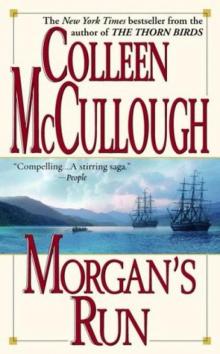 Morgan's Run
Morgan's Run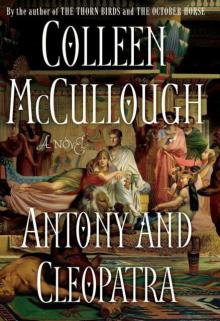 Antony and Cleopatra
Antony and Cleopatra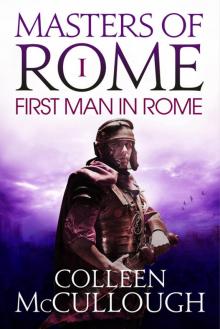 The First Man in Rome
The First Man in Rome Caesar
Caesar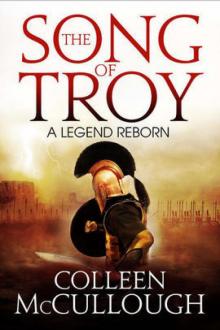 The Song of Troy
The Song of Troy Fortune's Favorites
Fortune's Favorites The Touch
The Touch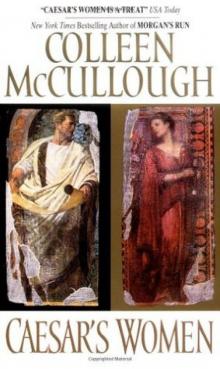 Caesar's Women
Caesar's Women The Independence of Miss Mary Bennet
The Independence of Miss Mary Bennet The Grass Crown
The Grass Crown Tim
Tim Bittersweet
Bittersweet Angel
Angel 3. Fortune's Favorites
3. Fortune's Favorites Sins of the Flesh
Sins of the Flesh 2. The Grass Crown
2. The Grass Crown Life Without The Boring Bits
Life Without The Boring Bits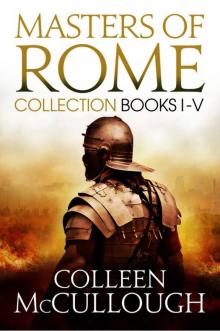 Masters of Rome Boxset: First Man in Rome, the Grass Crown, Fortune's Favourites, Caesar's Women, Caesar
Masters of Rome Boxset: First Man in Rome, the Grass Crown, Fortune's Favourites, Caesar's Women, Caesar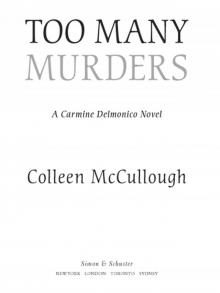 Too Many Murders
Too Many Murders 1. First Man in Rome
1. First Man in Rome On, Off
On, Off 5. Caesar
5. Caesar Naked Cruelty
Naked Cruelty 6. The October Horse: A Novel of Caesar and Cleopatra
6. The October Horse: A Novel of Caesar and Cleopatra